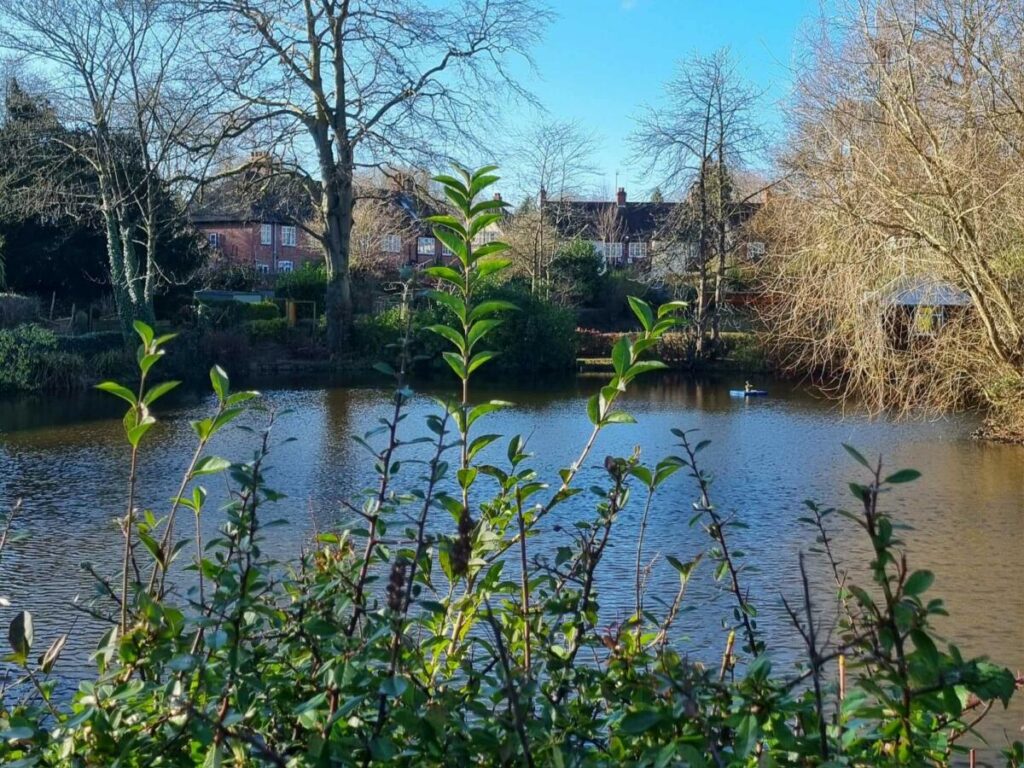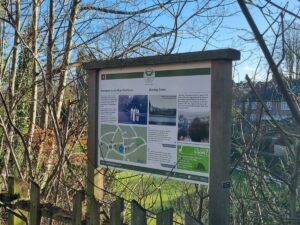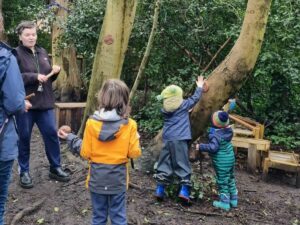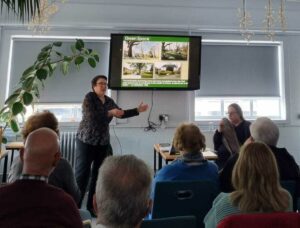
Moor Pool estate office is nestled between stretching trees and winding roads. Home to 200 trees and 200 allotments, it is a sparkling example of living history. Over the past few weeks, I have been on placement at Moor Pool Heritage Trust as a part of my History Masters Programme at the University of Birmingham. On my first day, I followed a self-guided trail around the estate. I started at The Circle and learned about the communal heart of the estate: Moor Pool Hall. The Hall hosted dances, weddings, drama performances, and musical competitions. From further research into newspaper archives, I have seen a 1914 Moor Pool Music Festival, a Horticultural Show, and even a 1920 Japanese Operetta performed by school children, were all hosted in Moor Pool Hall. However, this building is not a relic of the past but a part of living history. It is still used for a range of diverse events, from line dancing to rifle club, that bring the community together.
On my next day at Moor Pool, Barbara Nomikos, the Hall & Assets Manager, guided me around the estate and showed me a beautiful skittle alley beneath the hall. This is an original Edwardian Skittle Alley with the last surviving double alley, with a flat and rounded alley side by side. The alley is not placed behind glass and curtains, instead it is used every Monday evening by a regular Skittles club. The skittle alleys’ cultural legacy perseveres into the present day. The alley is protected by its regular use which allows people to actively engage, experience, and interact with history. Although only 11 people have achieved a perfect 30 on the alleys!

On my tour with Barbara, she delivered even more of Moor Pool’s story. As we walked around the circle she told me about John Sutton Nettlefield, a social reformer, who established Moor Pool estate in 1907. He aimed to design garden cities that included fresh air and open spaces. From 1801 to 1901 the Birmingham population jumped from 70,000 to 720,000 and so the availability of adequate housing became increasingly problematic. At Moor Pool, Nettlefold renovated back-to-back houses by knocking out 2 sides to get more green spaces and air. While 42 houses per acre was the standard practice, at Moor Pool there were just 9 houses per acre. These houses worked around the contours of the trees, hedges, and the natural pool. Interestingly, these hedges helped provide private space and hidden pathways that provided alternative routes from the busy roads. Each house had a fruit tree and ample green space to promote healthy living.

Much of the ethos of Moor Pool lives on and throughout my placement, I have witnessed the hard work that goes into preserving these ideals. One example is the Forest School sessions Justine Marklew, the Education & Community Outreach Officer, runs for children. These sessions encourage children to play and interact with the outdoors and woodland spaces and encourage creativity and curiosity. In the forest school session, the children were tasked with making Boggarts, mythical and mischievous creatures, made out of imagination and an all-natural clay. The children scavenged the forest floor for leaves and twigs to give their boggarts long arms, noses, and frazzled hair. I managed to create a boggart with a beautiful set of green eyelashes and green pointed wings. We then sat in a circle atop tree stumps, caked in mud, and discussed where boggarts might hiding from us. We learned about woodland safety, and how to protect ourselves and the environment around us. This forest school aligns with the idea of the ‘garden city’ by offering a piece of the country and encouraging children to move their bodies, sharpen their minds, and in this case, get muddy!
Community engagement does not stop there. There are a whole host of events throughout the year. With the helpful guidance of Clare Gordon, the Marketing & Administration Coordinator, I received website training and uploaded multiple events to the webpage, including book clubs and a series of historical talks. I also created promotional media for these historical talks. I enjoyed using my creativity through the design website Canva to create an informative poster that reflected the character of the Trust. However, I did struggle to fit all the names, titles, and times of the talks without making the text ridiculously small in size 2 font!

I had the pleasure of attending one of these talks at Winterbourne Gardens, where I learned more about the estate and the ideas behind Moor Pool’s inception. One such is housing co-partnership. Housing co-partnership was a social movement that combined features of tenant co-operative and a limited dividend company so that residents own properties as a collective group by paying into one mortgage. This was an investment not only in their homes but the community and its assets. Recreation and activities were a central part of this ethos. Barbara Iken, who lived at Margaret Grove since her birth in 1925, remembers going to the office at the circle to pay rent to a Ms ‘battle-axe’ Lygoe. Ideas of community are alive at Moor Pool today and exemplified beautifully in the Hall and over 21 ongoing clubs. The tennis courts, skittle alleys, and pool tables have brought people together in the past and they continue to bring people together today. I am glad to have witnessed and experienced the community alive at Moor Pool throughout my placement.
By Amber Saucedo, MA Early Modern History Student.
Moor Pool Hall
37 The Circle, Harborne,
Birmingham, B17 9DY
Registered Charity Number: 1148252
© 2025 All rights reserved | Website by Citrus Frog